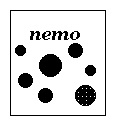 NEMO - A Stellar Dynamics Toolbox
NEMO - A Stellar Dynamics Toolbox  NEMO - A Stellar Dynamics Toolbox
NEMO - A Stellar Dynamics Toolbox  :
NEMO is now managed with git and hosted on
github, with a copy
on
Software Heritage archive.
:
NEMO is now managed with git and hosted on
github, with a copy
on
Software Heritage archive.

 Documentation
Documentation  Example scripts
to highlight certain procedures or packages in NEMO.
Example scripts
to highlight certain procedures or packages in NEMO.
 Images and Snapshots
Images and Snapshots  Papers
Papers Teuben, P.J. The Stellar Dynamics Toolbox NEMO, in: Astronomical Data Analysis Software and Systems IV, ed. R. Shaw, H.E. Payne and J.J.E. Hayes. (1995), PASP Conf Series 77, p398.
 Installation
Installation
%1 wget https://teuben.github.io/nemo/install_nemo.sh
%2 chmod +x install_nemo.sh
%3 ./install_nemo,sh nemo=$HOME/opt/nemo
%4 source $HOME/opt/nemo/nemo_start.sh
There are some assumptions in these 4 basic steps. For the 1st step,
if you don't have the wget program, get something
similar that can download this script, e.g. curl, or just your favorite browser.
You can of course pick the
location of NEMO to be anywhere, but we picked $HOME/opt/nemo in this example.
% git checkout nemo_4_0_2
would get you the equivalence of the 4.0.2 release.
Although old tags in the 3.x series exist when NEMO was maintained in CVS,
installation procedures and directory structures were different, which we
don't support anymore. You will be on your own here.
 Other Software
Other Software  AMUSE:
a software framework for large-scale simulations of dense stellar systems,
in which existing codes for dynamics, stellar evolution, hydrodynamics
and radiative transfer can be easily coupled.
AMUSE:
a software framework for large-scale simulations of dense stellar systems,
in which existing codes for dynamics, stellar evolution, hydrodynamics
and radiative transfer can be easily coupled.
 initialconditions.org, a blog on Astrophysical
Initial conditions (for the N-body problem).
initialconditions.org, a blog on Astrophysical
Initial conditions (for the N-body problem).
 Gravetat:
gravity and electromagnetism simulator
Gravetat:
gravity and electromagnetism simulator
 Moody,
a cross platform concurrent n-body modelling framework written in C++.
Moody,
a cross platform concurrent n-body modelling framework written in C++.
 discussion forum is
here.
discussion forum is
here.
 N-Body Data Interchange Format
N-Body Data Interchange Format  Local Information
Local Information